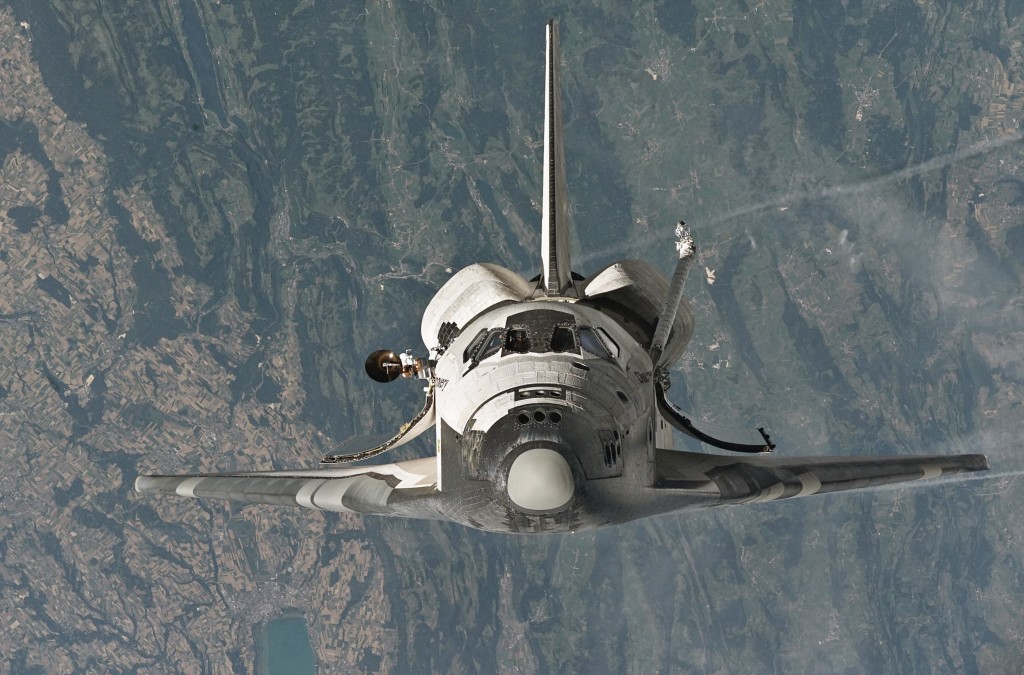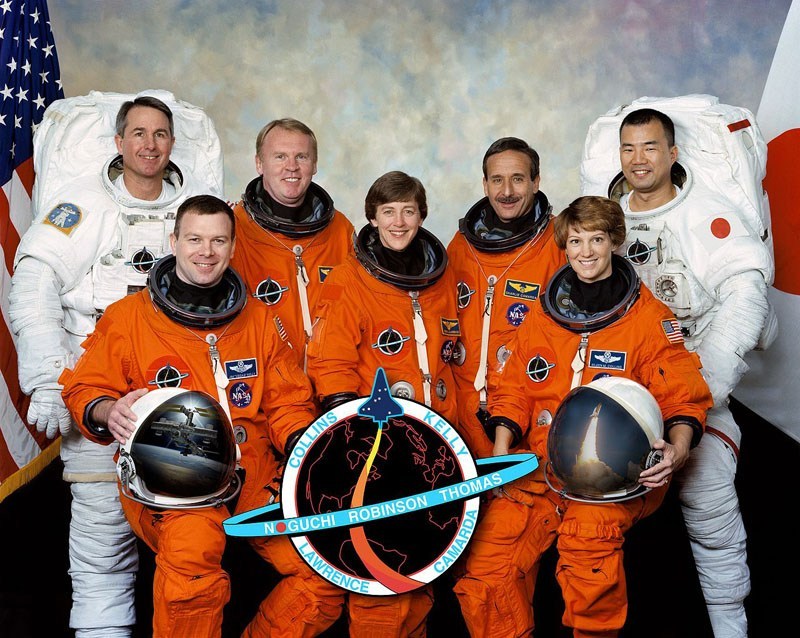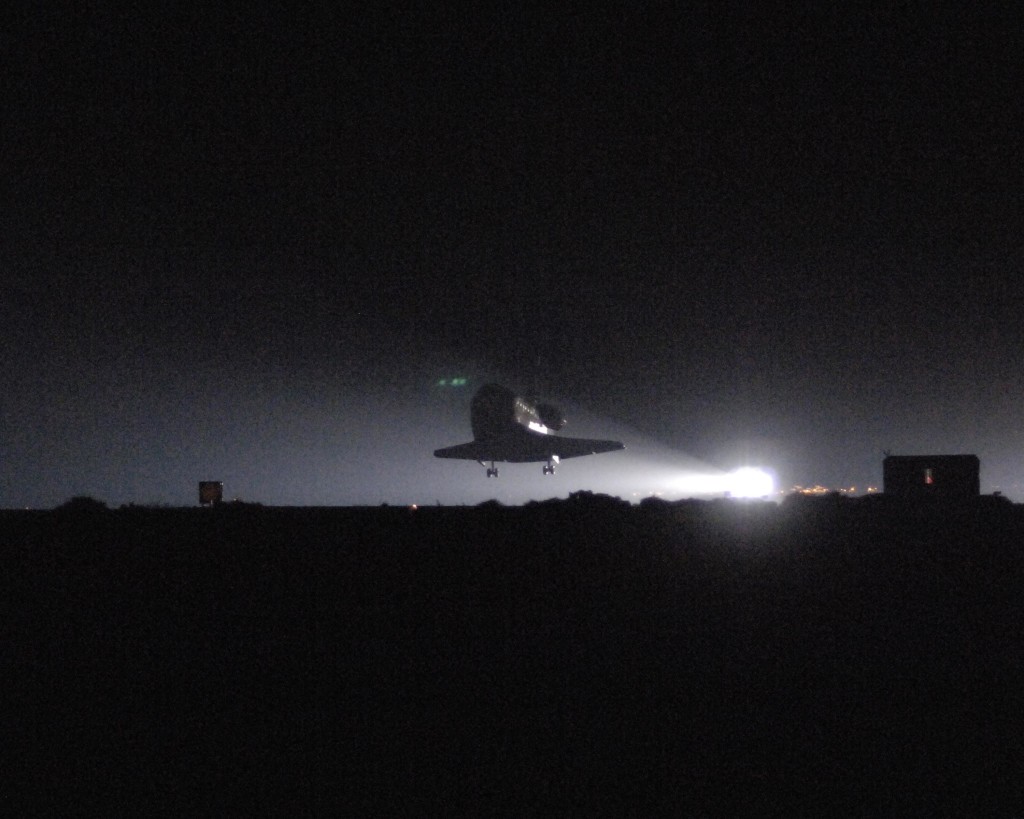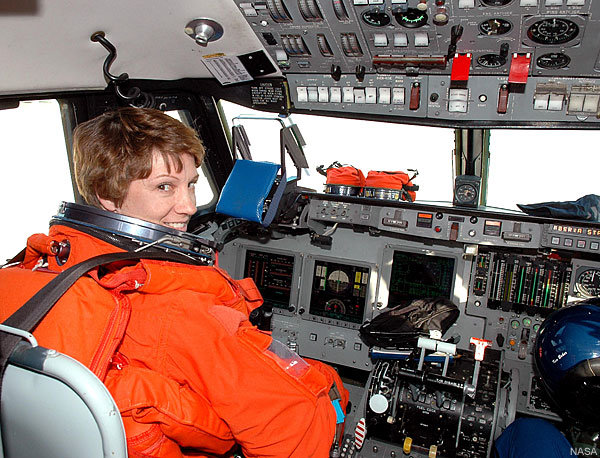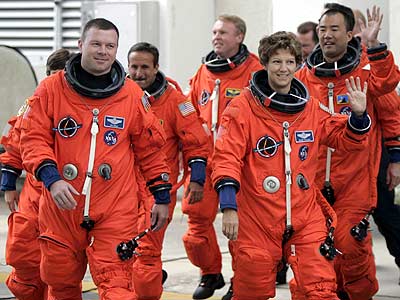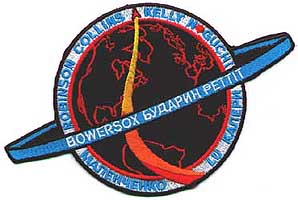Testimony of Pilot# 10
In 1990, Eileen Collins was only the second woman to graduate as a test pilot and be selected as a NASA astronaut. She became the first woman to pilot a space shuttle mission during the Discovery’s rendezvous with Mir space station in 1995 and became the first female commander of a US spacecraft on Space Shuttle Columbia on STS-93.
Her fourth and final mission was to resupply the International Space Station (ISS) as commander of Space Shuttle Discovery on STS-114 which heralded the “return to flight” of the Space Shuttle after the Columbia disaster. Discovery launched on July 26 and spent almost 14 days in orbit. During this mission, Astronaut Eileen Collins became the first person to fly the Space Shuttle through a 360 degree pitch maneuver so astronauts aboard the International Space Station (ISS) could check the belly of the Shuttle and make sure there was no threat from debris related damage on reentry.
The thoughts of Eileen Collins related to the Space Shuttle return to flight seem most appropriate as testimony in the Chapter entitled Harnessing the Sky. TINS
Selected Comments of Eileen Collins, STS-114 Discovery Mission Commander
From
From NASA Interviews and Speeches
STS-114 Pre-flight interview:
NASA: It’s been more than two years since Columbia and its crew were lost. Eileen, what was it like for you as an astronaut to deal with the reality of the fact that an accident had claimed the lives of seven of your friends?
Well, that’s a tough question. I think now the way I’d like to deal with that question is, I’d like to talk about the future. We will always remember Columbia and its crew. We fly knowing that there’s risk, and the risk that’s probably going to get us is something that’s unknown. We have flown a very safe, extremely safe, Space Shuttle program since the Challenger accident; it was 17 years between Challenger and Columbia. The program I felt was run very, very safely. I have very high confidence in flying the Shuttle orbiters, very high confidence in the people, in the program. But there are risks in spaceflight and there are unknowns. We try to understand as much of it as we can.
The Columbia astronauts understood what the risks were. I think we had gotten to a point where we were getting pretty confident because we had 17 years. We had a couple of times when we didn’t fly because we had to go fix something, and we fixed it successfully and we’d get flying again. It’s time to move on. We will always remember our friends, but it’s time to take what they lived for and what they believed in — space exploration — and move on and get the Shuttle flying again. We need to get the Space Station built, and I know that’s what they would want us to do. And that’s not the end of it.
From there we’re going to go on to the moon and Mars. People have given their lives throughout history in the name of making the Earth a better place to live for everybody. I certainly consider the Columbia and the Challenger. The whole history of the space program is part of moving on and making life better for people on Earth. I want to carry on their work on through the Shuttle, the Station, and the space exploration initiative. I think that’s the way I see it now, and that’s the way I will continue to feel, throughout this flight and, and even afterwards.
NASA: Have you and your crew mates talked about ways that you can honor their memory and their spirit while you’re flying your mission?
Well, we’re certainly going to do something on this mission to remember Columbia and its crew, something as simple as flying a, a photograph of the crew and displaying it where we can see it every day. We can remember them, and say a prayer for them every day in space. I certainly will continue to remember them and between now and, and when we actually fly the mission we’re going to have some things to, to remember them that I think will be special.
NASA: We always would assume that an astronaut understands the risks that are involved in the job they do, and I guess it’s probably even clearer to us since the loss of Columbia and its crew. Tell me why you feel this job is worth that risk, for you.
I am a huge believer in human exploration. Just think about the history of our country and the history of the world. People have flourished around this planet because I think we humans have something inside of us, a need to explore. And I think some people have it more than others. You have the people who 500 years ago got on these old ships and sailed across the Atlantic Ocean or they sailed across the Pacific Ocean, looking for something new, looking for a better life, looking for a better economy, a way to make money. Whatever they were looking for, they were explorers. And we still have people today that like to do that. For me, it’s almost a need to explore. I like to get out and do new things and see new things. When it comes to flying in space, we’re taking very, very small steps.
We’re flying the Space Shuttle right now, we’re building a Space Station, we’re going to go on from the Space Station, back to the moon and on to Mars. To me, it is very important for humans to get off the planet and go do these things. Because I believe in this so much, I think that yes, there is risk in space travel, but I think that it’s safe enough that I’m willing to take the risk. I think it’s much, much safer than what our ancestors did in traveling across the Atlantic Ocean in an old ship. Frankly, I think they were crazy doing that, but, but they wanted to do that, and we need to carry on the human exploration of the universe that we live in. I’m honored to be part of that and I’m proud to be part of it. I want to be able to hand on that belief or enthusiasm that I have to the younger generation because I want us to continue to explore.
NASA: The last big event on the flight, the entry and the landing, is going to get more attention than probably any other entry and landing has, maybe ever. What are your thoughts about that part of this flight?
Well just like any other segment of the flight we’re training for the deorbit prep, the deorbit burn, the entry, and the landing. We break it up into different pieces and we train for that. I think back to my re-entries on my other flights. It is a very exciting part of the mission. You can see the Earth below you. You’re traveling at Mach 25 over the surface of the Earth — technically you’re still in space. If you’re coming in at night you can see the orbiter glow around you. It’s really just a fantastic experience. I don’t want to be distracted by that.
We have a job on the orbiter, monitoring our entry attitude, our air speeds, the orbiter systems. Is the flight control system doing what it’s supposed to do? So we actually have a job on orbit. I try not to think about the distractions that are going on around me. I try to just focus on getting my job done. The entry goes very fast, as I just said; next thing you know, you’re flying the heading alignment cone at Kennedy Space Center or Edwards, wherever your landing site is. It’s like the time just speeds up, and next thing you know you’re landing. So I’m going to, as I did in my last flight, just revert to my training, the Shuttle Training Aircraft, I just pretend I’m flying a Shuttle Training Aircraft. It’s such good training that it actually translates well to the actual orbiter. The difference is you’re going from a zero g environment on the real day to one g, which feels a lot more like, like one g the day you launched. It’s quite a physiological change to your body when you come in and land. So we’re landing under those stresses. My crew making calls to me, and I’ve got the ground calling, you know, what are the winds — we’ve had the support from the Shuttle Training Aircraft.
I feel like all this training that I’ve done is finally going to come together and I’m going to focus on the landing. I try not to let the distractions come into play, and it’ll be very, very procedure-oriented and very by the book.
NASA: How different did you find the transition from being Pilot on the second mission to being Commander on your third knowing you have someone else as your pilot?
I felt very prepared to move into the Commanders side, mostly because when I was in the Air Force I was the aircraft commander and had moved into that, previously being an instructor pilot, you are the aircraft commander as the instructor pilot as there’s only two of you. Then I flew cargo on the C141 (Starlifter), had flew quite a while as co-pilot, had seen a lot, had seen enough experience as commander and we would take a crew of 7 around the world in the C141. For the most part you were the decision maker on the flight, you let the crew do their job, come to me if you have a problem. So when I went to the shuttle program, I felt philosophically and mentally I was ready for the commander position, I just needed to learn the technical side because the commander also operate the computer and life support system, the pilot does everything else.
Post STS-114 comments:
We flew the Space Shuttle mission right after the Columbia accident, but it was actually 2 1/2 years after the accident. We became a test flight for looking at ways to repair a Space Shuttle in orbit if there was damage to the heat shield. It was something they were doing in the initial part of the Shuttle program but it was too hard so they gave up on it.
We looked at it at the end of the Columbia accident in 2003, because as the crew came home, there was a hole in the wing, the hole got bigger because a piece of foam fell of the external tank during launch and it hit the Shuttle at high-speed. This could happen again in the future even though we’d worked hard keep the foam from falling off. Just in case it did happen again, we wanted a way to repair the Shuttle in orbit. The first spacewalk we did was in the payload bay where we put a couple of broken tiles and my crew tried to repair those, with the pieces brought back at the end of the flight to put in the heat chamber and test it to see if that repair worked and could be used on future space missions and repair the heat shield in space.
The rendezvous is all hand flown by the shuttle commander, you could automate it but we hand fly it because we have more control, its little more soft and the docking little more accurate. We were the first crew to do the (RPM) rendezvous pitch maneuver, which is very slow, the only part of the rendezvous we flew on autopilot. The crew on the ISS then photograph the entire underside of the shuttle. When we’re docking with the space station, I’m not looking out the window, I’m looking at the laptop where there is an image from the camera in the docking ring, closing at .1 feet per second and when we get just two inches away, I fire jets to get a firm docking, then we equalize the pressure and open the hatch.
The other fun side of going into space is looking back at the earth. People ask me what the stars look like, we don’t normally do that because it looks a lot like it does on Earth except stars don’t twinkle because there’s no atmosphere. So we look at the Earth, you’ll never see that view again unless you go into space again.
Questions:
The last NASA selection was 50/50 men and women, how long do you think there’ll be an all women crew and is it actually a good idea?
Oh what a question, I could tell you stories….we had a lot of jokes about it, within the women ourselves. I don’t think NASA would ever had flown an all women crew in the shuttle era and I didn’t want to fly an all women crew. When I was a Commander, Pam Melrose was a pilot, along with plenty of other mission specialists, we could have flown all women crews, but the problem is everytime that every little thing that broke would be blamed on the women. The fuel cell failed, well its not the crews fault, you put all those women together. On my first mission, there were high seas, a stormy February night, we launched, the boosters came down and hit the water, the crew has nothing to do with the boosters once they separate, they towed them back in, there was dent in the booster, it was the way they hit the wave. I heard after the fact that that they were all joking “look what happens when you get a woman driver.”
A surprising number of astronauts have suffered from nausea and space sickness, is that still the case or are we developing ways of handling that?
It is still the case but not as much as it used to be. We know that a percentage of astronauts are going to get nauseous, the crew members I’ve flown with, the first time flyers, I’m amazed at who gets sick. You imagine a pilot that they’re not going to get sick but then they get stomach awareness. Some people have back pain because your back stretches but the biggest problem is the stomach awareness.
What we do nowadays is to take medicine, doctors let mission specialists take them before flight, anti-nausea phenergan or dexedrine which would keep you from getting sleepy; it works. Doctors wouldn’t allow pilots and commanders to take it because they thought it might makes sleepy of affect the way we think. As soon as I got to orbit, I’d take a pill, you don’t want to wait. If you’ve flown before, you’d probably not going to have it again, your body learns.
Before we close, I want to say a word about the space station in orbit. The purpose of it is to study the human body in space, that is its number one purpose. The astronauts volunteer their body, have to do all kinds of tests. But there are also some interesting things going on up there, all kind of technology development, 3D printing,studying bone loss, research into protein crystal growth to help us develop better medicines, plant and animal growth. Its a laboratory in space, its expensive to get your experiment up there, hoping to develop rockets and make it cheaper and fully utilise the space station.
The ISS has been extended to 2024 and trying to extend it to 2028 and get the international partners to join in. I hope we turn the ISS over to tourists and let somebody else run it so tourists can go up there and have fun and enjoy being up in space. That is the human spaceflight program.
*******************
Eileen Marie Collins is a retired American astronaut and a retired 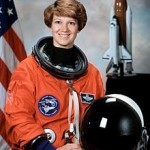 U.S. Air Force Colonel. In 1990, she was only the second woman to graduate as a test pilot and be selected as a NASA astronaut. She became the first woman to pilot a space shuttle mission during the Discovery’s rendezvous with Mir space station in 1995.
U.S. Air Force Colonel. In 1990, she was only the second woman to graduate as a test pilot and be selected as a NASA astronaut. She became the first woman to pilot a space shuttle mission during the Discovery’s rendezvous with Mir space station in 1995.
Collins has logged 38 days 8 hours and 10 minutes in outer space. She flew Space Shuttle Discovery as pilot on STS-63 rendezvousing with the Russian space station Mir and as pilot of Space Shuttle Atlantis on STS-84 again docking with Mir. Astronaut Collins became the first female commander of a US spacecraft on Space Shuttle Columbia on STS-93. She retired on May 1, 2006 to pursue private interests and serves as a board member for USAA.
Colonel Collins has been awarded the Defense Superior Service Medal, Distinguished Flying Cross, Defense Meritorious Service Medal, Air Force Meritorious Service Medal with one oak leaf cluster, Air Force Commendation Medal with one oak leaf cluster, Armed Forces Expeditionary Medal for service in Grenada (Operation Urgent Fury), French Legion of Honor, NASA Outstanding Leadership Medal, NASA Space Flight Medals, Free Spirit Award, and the National Space Trophy.
*************************
The STS-114 patch design signifies the return of the Space Shuttle to flight and honors the memory of the STS-107 Columbia crew. The blue Shuttle rising above Earths horizon includes the Columbia constellation of seven stars, echoing the STS-107 patch and commemorating the seven members of that mission. The crew of STS-114 will carry the memory of their friends on Columbia and the legacy of their mission back into Earth orbit. The dominant design element of the STS-114 patch is the planet Earth, which represents the unity and dedication of the many people whose efforts allows the Shuttle to safely return to flight.
Against the background of the Earth at night, the blue orbit represents the International Space Station (ISS), with the EVA crew members named on the orbit. The red sun on the orbit signifies the contributions of the Japanese Space Agency to the mission and to the ISS program. The multi-colored Shuttle plume represents the broad spectrum of challenges for this mission, including Shuttle inspection and repair experiments, and International Space Station re-supply and repair.

